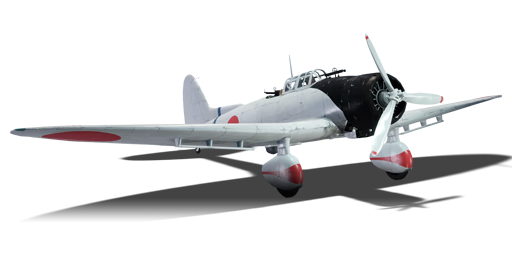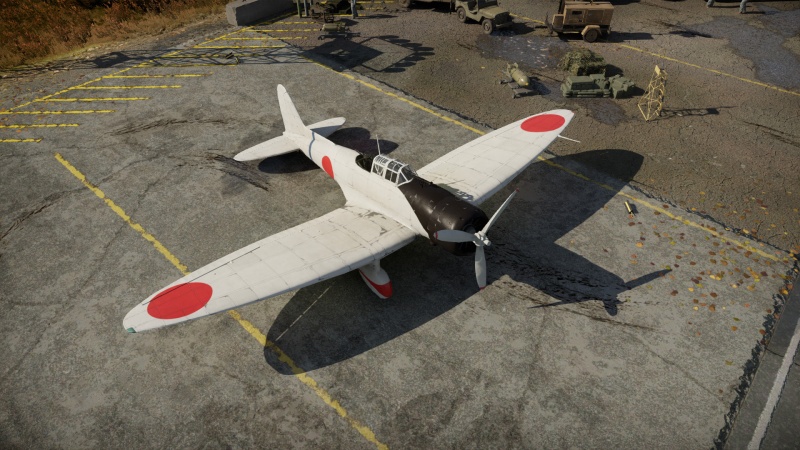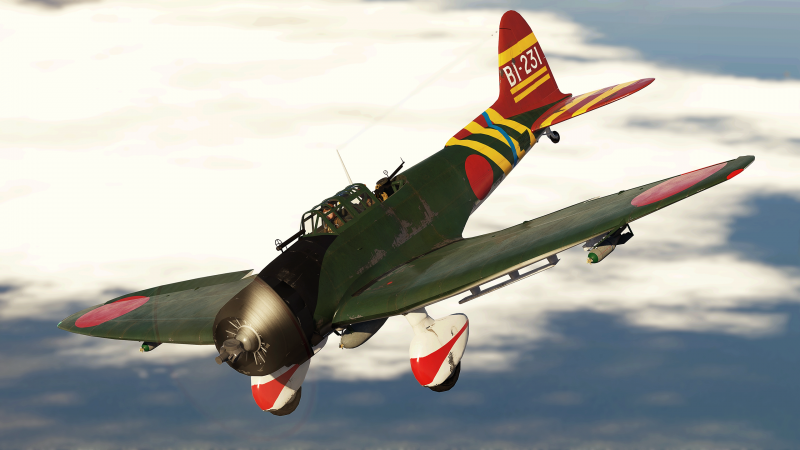D3A1
Contents
Description
The D3A1, designated as Type 99 Carrier Dive Bomber (九九式艦上爆撃機), is a rank I Japanese dive bomber with a battle rating of 1.3 (AB/RB/SB). It has been in the game since the start of the Open Beta Test prior to Update 1.27.
Being the first plane to bomb American targets during WWII, it also sunk the most Allied vessels out of any other Axis Aircraft.
- Japanese Pilots usually abbreviated the Type 99 Carrier Dive Bomber (九九式艦上爆撃機) as Kanbaku (艦爆).
- The Allied reporting name of the D3A1 was Val.
General info
Flight performance
The D3A1 is among the early war dive bombers of all nations, one of the fastest and most manoeuvrable of them all, allowing the D3A1 to hit hard and fast, while making it back to base in quick succession. This does come at the cost of only offering a limited payload of 1 x 250 kg and 2 x 60 kg bombs.
| Characteristics | Max Speed (km/h at 3,900 m) |
Max altitude (metres) |
Turn time (seconds) |
Rate of climb (metres/second) |
Take-off run (metres) | |||
|---|---|---|---|---|---|---|---|---|
| AB | RB | AB | RB | AB | RB | |||
| Stock | 417 | 408 | 10500 | 30.0 | 30.6 | 6.4 | 6.4 | 232 |
| Upgraded | 443 | 430 | 28.5 | 29.2 | 11.1 | 8.6 | ||
Details
| Features | ||||
|---|---|---|---|---|
| Combat flaps | Take-off flaps | Landing flaps | Air brakes | Arrestor gear |
| ✓ | ✓ | ✓ | ✓ | ✓ |
| Limits | ||||||
|---|---|---|---|---|---|---|
| Wings (km/h) | Gear (km/h) | Flaps (km/h) | Max Static G | |||
| Combat | Take-off | Landing | + | - | ||
| 600 | 650 | 458 | 429 | 280 | ~12 | ~4 |
| Optimal velocities (km/h) | |||
|---|---|---|---|
| Ailerons | Rudder | Elevators | Radiator |
| < 330 | < 360 | < 380 | > 315 |
| Compressor (RB/SB) | ||
|---|---|---|
| Setting 1 | ||
| Optimal altitude | 100% Engine power | WEP Engine power |
| 1,700 m | 1,065 hp | 1,118 hp |
Survivability and armour
The D3A1 lacks any armour protection, but its three fuel tanks are self-sealing. One is located beneath the pilot, and the other two are in the wings, one in each wing. The gunner is exposed (his head sticks out of the aircraft).
Modifications and economy
- When grinding the D3A1 it's preferred to focus on grinding for the performance as the bomb load is already unlocked. The armaments should be focus last as performance is the key trait of the D3A1.
Armaments
Offensive armament
The D3A1 is armed with:
- 2 x 7.7 mm Type 97 navy machine guns, nose-mounted (900 rpg = 1,800 total)
While only armed with 2 x nose-mounted 7.7 mm Type 97 machine guns, they still can pose a threat to underestimating foes, while only rifle-calibre, they can still knock out open-topped tanks and trucks, and with the superb manoeuvrability for a dive bomber, it can keep up in a dogfight.
Suspended armament
The D3A1 can be outfitted with the following ordnance:
- Without load
- 1 x 250 kg Navy Type Number 25 Model 2 bomb + 2 x 60 kg Navy Type 97 Number 6 bombs (370 kg total)
While it only comes with a single preset of 1 x 250 kg & 2 x 60 kg, it still is more than a threat for any target it will be dropped upon, be it a tank or ship, the 250 kg will make short work of it, with the 60 kg allowing more novice pilots to precise bomb for ground targets or smaller vessels.
Defensive armament
The D3A1 is defended by:
- 1 x 7.7 mm Type 92 machine gun, dorsal turret (1,000 rpg)
The D3A1 is defended by a single Type 92 MG in the tail gunner position. While offering not much punch, the dorsal MG will still fend off any attackers staying directly behind the tail of the D3A1.
Usage in battles
The D3A1 is Japan's early dive bomber, a highly manoeuvrable aircraft that is able to outturn a lot of enemies and avoid bursts of fire. Having a small turn radius gives the D3A1 a chance to defend itself by getting on the tail of enemy, but if the enemy is smart enough and doesn't try to turn with the D3A1, they can run away from the D3A1 after it has lost a bit of speed in turning around to get on the tail. But the D3A1 can still get in a couple of hits.
D3A1 is capable of carrying a modest bomb load which is similar to early versions of Ju 87. But it's also similar in terms of firepower as well with 2 x 7.7 mm Type 97 navy machine guns which can be used to defend itself from enemies, but also strafe light targets like AA/howitzer postions and light armoured vehicles like trucks and SPAA. D3A1 also has a defensive Type 92 machine gun mounted on the back, the gunner has an impressive area of cover which eliminates most dead zones that other dive bombers and some bombers have.
Main use of the D3A1 is dive bombing, that is where its strength lies, knocking out ground targets in ground battles or the AI targets in air battles, being able to dive near ground using the air brakes for accurate drop of bombs. After dropping bombs the D3A1 can be used as a fighter, but keep in mind that it has a relatively unprotected pilot and gunner, which makes it easy for enemy fighters and vehicles on the ground with AA-mounted machine guns to knock these out. The plane does not react well to being hit as well but it can still function relatively well even when damaged and can still put up a fight. Aircraft and vehicles equipped with 12.7 mm and above will make a quick work of the D3A1 either by getting the pilots or vital parts of the plane but also to set it on fire. 7.92 mm and below can also pose a threat if there is more than 1 mainly.
Enemies to be aware of:
- P-40E-1, P-400, He 100 D-1, Bf 109 E-1, P-66, H-81A-2 - These enemy fighters possess sufficient firepower and speed over the D3A1 to easily outclimb, outrun, and outgun the D3A1. They will Boom-n-Zoom the D3A1 and run away fast to prepare for the next attack, giving the D3A1 no chance to defend itself with its offensive machine guns.
- I-153 M-62 - The I-153 can outturn the D3A1 with ease and therefore will have no problem tailing the bomber in evasive manoeuvres.
- Tip for taking off in simulator battles
Hands-off carrier take-off (Auto engine control, no secondary weapons):
- Start engine
- Flaps: raised
- Elevator trim: 8% up
- Aileron trim: 0%
- Rudder trim: 21% right
- WEP throttle
- Hands off controls until your plane lifts off the carrier
Manual Engine Control
| MEC elements | ||||||
|---|---|---|---|---|---|---|
| Mixer | Pitch | Radiator | Supercharger | Turbocharger | ||
| Oil | Water | Type | ||||
| Not controllable | Controllable Not auto controlled |
Not controllable Not auto controlled |
Controllable Not auto controlled |
Combined | Not controllable 1 gear |
Not controllable |
Pros and cons
Pros:
- D3A for Carrier-based dive bomber:
- 250 kg + 2 x 60 kg
- Bomber airspawn
- Airbrakes
- Common Navy plane construction:
- Nose-mounted armament
- Excellent manoeuvrability
- the D3A1 has self-sealing fuel tanks
Cons:
- D3A for Carrier-based dive bomber:
- Has bomb cradle, significant delay in fuselage bomb drop
- Not good for bombing bases
- Common Navy plane construction:
- Poor offensive armament: 7.7 mm Type 97 MG
- Poor defensive armament: 7.7 mm Type 92 MG
- Fragile, little armour
- Exposed tail gunner
- D3A1 Specific:
- Payload is rather weak
History
Development
- 11-Shi Carrier Bomber
Developed as the 11-Shi Carrier Dive-Bomber, it was a specification ordered by the Imperial Japanese Navy Aviation Bureau to replace the obsolete D1A biplane. The task was undertaken by Mitsubishi, Nakajima, and Aichi, with Mitsubishi dropping out of the design contest early after submitting their design. With the Navy having a civilian model of the Heinkel He 70 for evaluation and testing, Aichi decided to use the plane as a template, while Nakajima based theirs on their own B5N torpedo bomber and C3N recon plane.
With Aichi basing its prototype off the He 70, many of its features such as all-metal fixed legs, dive air brakes, and the low-wing type were adopted into the Aichi 11-Shi. The initial model was finished in December 1937 and tested with the Nakajima Hikari 1 engine, which was also present on the D1A. The engine was underpowered and its airframe suffered from directional instability in wide turns, and in tighter turns it tended to snap roll. The dive brakes which were designed to withstand speeds up to 200 knots would start vibrating violently and with the navy requesting a higher dive speed of 240 knots, had to be redesigned. Nakajima's 11-Shi however missed the first deadline for the first prototype, but were still permitted to test the aircraft for the Bureau.
Aichi worked on the second prototype to cure most of its previous flaws by adding a larger tail combating directional instability, and wing span was increased against snap rolling on top of equipping stronger air brakes. The engine was switched out to the Mitsubishi Kinsei 3 in a new engine cowling. Together all of this would solve most of the issues of the first prototype except for directional instability. In 1939, both the Aichi and Nakajima prototypes were evaluated. Nakajima's was a progressive design at the time and was not bad in terms of performance, but it was inferior in speed and operability compared to the Aichi model and that was enough for the Aichi 11-Shi to be selected and officially designated as the Type 99 Carrier Bomber Model 11 (D3A1) which the navy ordered a production line to be built.
- (D3A1) Type 99 Carrier Bomber Model 11
The production version of the D3A1 switched out the engine once more for the Mitsubishi Kinsei 43 or 44 (most were equipped with Kinsei 44). The directional instability problem was finally cured with the fitting of a long dorsal fin-strake which started midway down the rear fuselage, and the aircraft actually became highly manoeuvrable.
Initially, Type 99 Carrier Bombers were painted in silver. During the summer of 1941, the paint finish changed to light olive grey. The colour changed again in early 1942 to dark green.
- (D3A2) Type 99 Carrier Bomber Model 22
With the pacific war raging on, the D3A1 became more and more unsatisfactory in terms of performance and by the end of August 1942, the navy requested an improved model for the D3A1. Aichi responded by changing the Kinsei 43 and 44 to the Kinsei 54 delivering 1,299 hp instead of the 1,000-1,070 hp the 43 and 44 offered, the engine change came with a new engine cowling and was equipped with a propeller spinner. Additionally, there was a rear extension of the windshield.
All these changes, mainly coming from the engine, decreased the operational range of the D3A, and as a solution drop tanks were possible to be installed. This variant would be dubbed the Type 99 Carrier Bomber Model 22 (D3A2) and would replace the model 11s on the frontline by autumn of 1942. All remaining model 11s were sent back to Japan and sent to training units.
In-game description
The single-engine carrier-based Aichi D3A dive bomber, a metal-construction monoplane, was created by order of Japan's Supreme Command of Naval Aviation to replace the obsolete D1A biplane. The shape of the wing and tail, as well as the presence of special dive brake flaps, came from the German aircraft company Heinkel, which was in active partnership with Aichi.
A D3A prototype was ready in late 1937, and mass production of the D3A1 began in 1940. A Kinsey 43 engine producing 1,000 horsepower was used, and the aircraft's armament consisted of two synchronous 7.7 mm machine guns over the engine and one hand-operated machine gun with the radio operator at the rear of the cab. The wings had folding wingtips and duralumin sheeting, and the ailerons and flaps were covered with fabric.
During the first half of the Second World War, the D3A, along with the B5N Kate, were the main strike force of the Japanese fleet. At the time the D3A1 could be considered one of the best dive-bombers in the world. No other dive bomber had characteristics that were even close, until the arrival of the American Dauntless and Helldiver.
All in all, 470 D3A1s were produced.
Media
- Skins
- Videos
See also
Links to the articles on the War Thunder Wiki that you think will be useful for the reader, for example:
- reference to the series of the aircraft;
- links to approximate analogues of other nations and research trees.
External links
| Aichi Aircraft Company, Limited (愛知航空機株式会社) | |
|---|---|
| Bombers | D3A1 |
| B7A2 · B7A2 (Homare 23) | |
| Recon | E13A1 |
| Japan bombers | |
|---|---|
| Navy | |
| Carrier-based attack bomber | |
| B5N | B5N2 |
| B6N | B6N1 · B6N2 · B6N2a |
| B7A | B7A2 · B7A2 (Homare 23) |
| Carrier-based dive bomber | |
| D3A | D3A1 |
| D4Y | D4Y1 · D4Y2 · D4Y3 Ko |
| Shipboard Observation seaplane | |
| F1M | F1M2 |
| Land-based Attack bomber | |
| G4M | G4M1 |
| G5N | G5N1 |
| G8N | G8N1 |
| Flying boat | |
| H6K | H6K4 |
| H8K | H8K2 · H8K3 |
| Land-based Bomber | |
| P1Y | P1Y1 |
| Army | |
| Light | Ki-32 |
| Ki-48-II otsu | |
| Heavy | Ki-21-Ia · Ki-21-I hei |
| Ki-49-I · Ki-49-IIa · Ki-49-IIb · Ki-49-IIb/L | |
| Ki-67-I Ko · Ki-67-I otsu | |
| Other countries | ▅B-17E |






